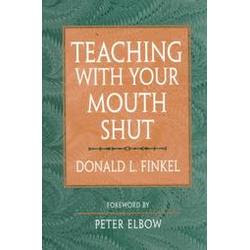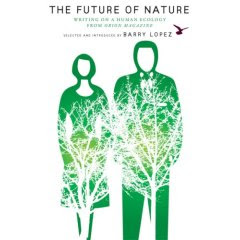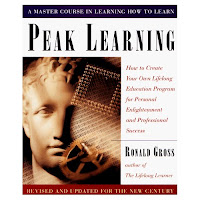For those interested, here are the Rochester Reads 2009 Title Suggestions thus far:
Suggestions from Community:
Last Child In the Woods: Saving our Children from Nature-Deficit Disorder by Richard Louv. 416 pages, paperback, $14.95. Suggested 9/4/07 by Judie Guhl, 289-3286
From Scientific American
Unstructured outdoor play was standard for me as a hyperactive child growing up in the rural Midwest. I fondly recall digging forts, climbing trees and catching frogs without concern for kidnappers or West Nile virus. According to newspaper columnist and child advocate Richard Louv, such carefree days are gone for America’s youth. Boys and girls now live a "denatured childhood," Louv writes in Last Child in the Woods. He cites multiple causes for why children spend less time outdoors and why they have less access to nature: our growing addiction to electronic media, the relinquishment of green spaces to development, parents’ exaggerated fears of natural and human predators, and the threat of lawsuits and vandalism that has prompted community officials to forbid access to their land. Drawing on personal experience and the perspectives of urban planners, educators, naturalists and psychologists, Louv links children’s alienation from nature to attention-deficit hyperactivity disorder, stress, depression and anxiety disorders, not to mention childhood obesity. The connections seem tenuous at times, but it is hard not to agree with him based on the acres of anecdotal evidence that he presents. According to Louv, the replacement of open meadows, woods and wetlands by manicured lawns, golf courses and housing developments has led children away from the natural world. What little time they spend outside is on designer playgrounds or fenced yards and is structured, safe and isolating. Such antiseptic spaces provide little opportunity for exploration, imagination or peaceful contemplation. Louv’s idea is not new. Theodore Roosevelt saw a prophylactic dose of nature as a counter to mounting urban malaise in the early 20th century, and others since have expanded on the theme. What Louv adds is a focus on the restorative qualities of nature for children. He recommends that we reacquaint our children and ourselves with nature through hiking, fishing, bird-watching and disorganized, creative play. By doing so, he argues, we may lessen the frequency and severity of emotional and mental ailments and come to recognize the importance of preserving nature. At times Louv seems to conflate physical activity (a game of freeze tag) with nature play (building a tree fort), and it is hard to know which benefits children most. This confusion may be caused by a deficiency in our larger understanding of the role nature plays in a child’s development. At Louv’s prompting, perhaps we will see further inquiry into this matter. In the meantime, parents, educators, therapists and city officials can benefit from taking seriously Louv’s call for a "nature-child reunion."
There Are No Shortcuts by Rafe Esquith. 224 pages, paperback, $13.95. Suggested by Jim Mickelson, 288-4160
From Booklist
Esquith, an award-winning elementary- school teacher, offers a passionate and inspiring look at his 19-year career. Early on, Esquith transferred from a public school in a middle-class neighborhood to a school in a low-income community with few native English speakers. In this frank account, Esquith details both his teaching mistakes and triumphs, and he advises young teachers and parents on how to actualize the enormous potential represented by public schools. In the chapter on reading, Esquith laments the mediocrity that is tolerated and practically encouraged at most schools, which focus more on classroom management and standardized tests than actual teaching. His personal approach is to expect the best of his students, including a strong work ethic. He extends the school day by three hours, teaches on Saturdays, and teaches English by having his students perform Shakespearean plays. With anecdotes that are alternately amusing and disheartening, Esquith details the joys and frustrations of teaching and offers valuable insights to parents and teachers alike. Vanessa Bush
Copyright © American Library Association. All rights reserved --This text refers to an out of print or unavailable edition of this title.
Freedom for the Thought We Hate: A Biography of the First Amendment by Anthony Lewis, 2008. 221 pages, hardcover, $25.00. Suggested by Frank Hawthorne
From Publishers Weekly
The First Amendment's injunction that Congress shall make no law... abridging the freedom of speech, or of the press seems cut and dried, but its application has had a vexed history, according to this lucid legal history, Lewis's first book in 15 years (after Make No Law and Gideon's Trumpet). Some suppressions of free speech passed constitutional muster in their day: the 1798 Sedition Act criminalized criticism of the president, and the WWI-era Sedition Act sentenced a minister to 15 years in prison for telling his Bible class that a Christian can take no part in the war. Law professor and Pulitzer Prize–winning ex-New York Times columnist Lewis explores other First Amendment legal quagmires, including libel law, privacy issues, the press's shielding of confidential sources, obscenity and hate speech. Not quite a free speech absolutist, he's for punishing speech that urges terrorist violence to an audience... whose members are ready to act. Lewis's story is about the advancement of freedom by the likes of Oliver Wendell Holmes Jr., Louis Brandeis and others whose bold judicial decisions have made the country what it is. The result is an occasionally stirring account of America's evolving idea of liberty.
Copyright © Reed Business Information, a division of Reed Elsevier Inc. All rights reserved.
Candyfreak: A Journey Through the Chocolate Underbelly of America by Steve Almond. 288 pages, paperback, $13.00. Suggested by Lynette Perry, to be paired with Charlie and the Chocolate Factory
From Booklist
Anyone who has ever really savored a piece of candy and appreciates more than its mere sweetness will sympathize with Almond's obsession. Much of the source of this addiction appears to stem from his psychiatrist father, who had a similar fixation. Then, of course, there is that surname, which his Polish immigrant grandfather took mostly as a way to ensure that he'd sort alphabetically to the top. Whatever its origins, Almond's passion for candy, chocolate or otherwise, leads him to inventory the various sweetmeats he has encountered throughout his life. He attempts to visit candy factories to back up his appetite with fact, but he discovers how very secretive candy manufacturers can be. He does achieve a tour of Pittsburgh's Clark bar factory, and there Almond finds out just how far the freshly made product surpasses the candy bar that has been sitting on a grocer's shelf. The decidedly regional nature of American candy production takes Almond to all sorts of destinations where he encounters those tastefully inventive minds who satisfy the country's sweet tooth. Mark Knoblauch
Copyright © American Library Association. All rights reserved --This text refers to the Hardcover edition.
Writing in an Age of Silence by Sara Paretsky, 2007. 138 pages, hardcover, $22.95. Suggested by Kim Edson
From Booklist
Fans of Paretsky's V. I. Warshawski series won't be surprised by her passion for social justice--in each novel, the sleuth tackles a political or social issue in addition to the crime at hand--and they're not likely to blame her for wanting to put the issues front and center. Despite having a popular series as a soapbox, Paretsky has much more to say. Derived from speeches and essays given and published elsewhere (an early version of chapter 5, "Truth, Lies, and Duct Tape," appeared in Booklist as "Writing, Speech, and Silence"), this slim volume covers a lot of ground: early lack of encouragement; participation in the civil-rights movement in Chicago; women's liberation and the origins of V. I. Warshawski; the social relevance of crime fiction; and the forces, from corporate enterprise to government censorship, conspiring to silence meaningful free speech. Written with graceful economy,Writing in an Age of Silence is an urgent cry for dissent and a powerful reminder that liberties taken for granted may someday not be granted at all. Keir Graff
Copyright © American Library Association. All rights reserved
Patron Suggestions from Greg Mortenson visit:
A Prairie Son by Dennis Clausen. 240 pages, paperback, $16.00
“Minn. Story – solid, rural, poignant, relates to many lives. Family farms v. conglomerates. Fullness of our lives vs. the past. Tables full of food from around the world.”
From Kirkus Reviews
The harrowing story of his father's youth on the Minnesota prairie, from novelist Clausen (Ghost Lover, not reviewed). When Clausen's father, Lloyd, died, he left (at his son's request) a rough outline of his life. Clausen pre had mostly been absent during Clausen fils's growing up; he was a cipher, though Dennis did know that Lloyd had had a rotten life as a child. So, using his father's sketch as a starting point, and broadening the story with material gathered from historical societies and newspapers of the time (and his father's few acquaintances), Clausen recreates his father's young manhood. And a sorry story it is. The author tells, in his father's voice, of being adopted by a farm family, not as a cherished member of the clan, but as cheap labor. Throughout the early years, he is ignored (when not being stropped) by his father and routinely tormented and physically abused by his mother. As a young boy, he summarized his life as ``chores, beatings, long hours locked up in the cellar.'' He takes solace in his dogs; feels confusion over the dark car that pulls up to the house when his father is out working in the fields; and is ineffably grateful for the small acts of kindness shown him by neighbors. The family's hard luck is so rudely ever-present, its as though they are the target of some malicious force: harvests go bad, cream is contaminated, the mother's affair is discovered (repeatedly), the hogs get cholera, the bank forecloses. Clausen lightens the tale with evocations of the rural landscape and with the rare sweet charactersuch as the Sanders brothers, who built windmills all day and played their violins at twilight. Sounding an authentic tone, the author steers clear of psychologizing, although his knowing innocence can aggravate. Its almost impossible to finish this chronicle of classic wretchedness without feeling a sudden appreciation for all things decent in ones life. -- Copyright ©1998, Kirkus Associates, LP. All rights reserved.
The Book Thief by Markus Zusak. 552 pages, paperback, $11.99
“It’s so readable and moving; it lets us see what ‘ordinary’ people did as quiet heroes to subvert the Nazis – I’ve been recommending it to everyone – it’s also charming. It shows how ordinary people stand up to evil – in small and large ways – and also learn to appreciate differences.”
From Kirkus Reviews
When Death tells a story, you pay attention. Liesel Meminger is a young girl growing up outside of Munich in Nazi Germany, and Death tells her story as "an attempt-a flying jump of an attempt-to prove to me that you, and your human existence, are worth it." When her foster father helps her learn to read and she discovers the power of words, Liesel begins stealing books from Nazi book burnings and the mayor's wife's library. As she becomes a better reader, she becomes a writer, writing a book about her life in such a miserable time. Liesel's experiences move Death to say, "I am haunted by humans." How could the human race be "so ugly and so glorious" at the same time? This big, expansive novel is a leisurely working out of fate, of seemingly chance encounters and events that ultimately touch, like dominoes as they collide. The writing is elegant, philosophical and moving. Even at its length, it's a work to read slowly and savor. Beautiful and important. (Fiction. 12+)
RART Recommendations:
The Dog Says How by Kevin Kling. 178 pages, hardcover, $22.95
From Library Journal
As a playwright (Fear and Loving in Minneapolis), humorist, and commentator on National Public Radio's All Things Considered, Kling is well known for his ability to find comedy in whatever life sends his way, first a birth defect, then a motorcycle accident that has limited his use of both arms. The title piece in this debut collection refers to a fight between Kling's cat and dog that causes his voice-activated computer software to respond by typing "How, how, why, why." Many of these 29 autobiographical tales recount childhood escapades with his father as they flew model airplanes or traveled on family car trips. "Dad's Day" shares the mixed-up phrases a neighbor, Mr. Sloan, creates to dispense wisdom, e.g., "It ain't rocket surgery, for crying outside." With Kling's frequent childhood visits to the emergency room, his father offered this wise instruction as Kling went on wild go-cart rides: "Don't get killed just because you know how." The tales range from a long line of family members who have survived lightning strikes to a third-generation farmer who decides to plant a field of sunflowers because he knows he will never be able to afford a Van Gogh. Recommended for all Minnesota libraries and for literary collections in larger public libraries.
In Search of Mockingbird by Loretta Ellsworth. 192 pages, hardcover, $16.95
Kirkus Reviews
Believing that the tattered copy of To Kill a Mockingbird she carries around is her only connection to her dead mother, bookish Erin is angry when her newly engaged father gives her the woman's teenaged diary as a 16th-birthday present. Reading that her mom also wanted to be a writer and even wrote to Mockingbird author Harper Lee, Erin acts on her long-held wish to meet her literary idol. Set over the course of a few days in 1986, and featuring a strong sense of the American landscape, Erin travels the thousand-plus miles from St. Paul, Minn. to Monroeville, Ala. on a bus. Along the way, she is shepherded by two quirky guardians: Sedushia, a middle-aged exotic dancer, and Epps, a big, protective computer geek. With a first-person narrative that is eloquent and credible, and prose that is restrained and economical, Ellsworth makes Erin's unlikely coming-of-age trip convincing. Designed to look like an old journal, the story's searching-for-mother theme should make it especially appealing to older fans of Kate DiCamillo's Because of Winn Dixie (2000) and Phyllis Reynolds Naylor's Alice Books. An engaging road trip. (Fiction. 10-14)
The Florist’s Daughter by Patricia Hample. 227 pages, hardcover, $24.00
Kirkus Reviews
A dutiful daughter-and superb memoirist-reflects upon the deaths of her parents. Hampl (English/Univ. of Minnesota; Blue Arabesque: A Search for the Sublime, 2006, etc.) has crafted an honest and loving tribute to her parents, who raised her in St. Paul, Minn., where she has remained virtually her entire life. Her father (the eponymous florist) and mother (a librarian) had different cultural histories. He was Czech; she, Irish. They worked hard, went to church, believed in truth, justice and the American way, did nothing the world would deem remarkable. And, Hampl says, "Nothing is harder to grasp than a relentlessly modest life." Her writings about that life highlight difficult truths about both the author and her parents. (It was her mother, she says, who made Hampl realize the coldness of her own heart.) Hampl begins at the hospital bedside of her mother, who lay dying after a stroke. She holds her hand and tries, simultaneously, to take notes. Several times in the ensuing text she returns to this scene-the hand-holding, the death-watch-until no life remains in the room but her own. The author moves back in time, telling us about her father's business (the employees, the customers, the economics of flower growing and selling) and her mother's career (she loved biographies). She adds that both had mixed feelings about her decision to become a poet. Her father, she says, thought "being a poet was all right, though hopeless." Her mother eventually created an archive of Hampl's work-every clipping, every note, every word she wrote. Hampl mentions occasionally her more conservative brother, who became a dentist and moved west, but his story is on the periphery. Death is the principal character, and Hampl shows us powerfully that Death touches not only the dying. A memoir for memoirists to admire-with language that pierces.
 Gladwell is an absolute pleasure to read. He takes a seemingly simple notion, and then he flips it on its head.
Gladwell is an absolute pleasure to read. He takes a seemingly simple notion, and then he flips it on its head.


































